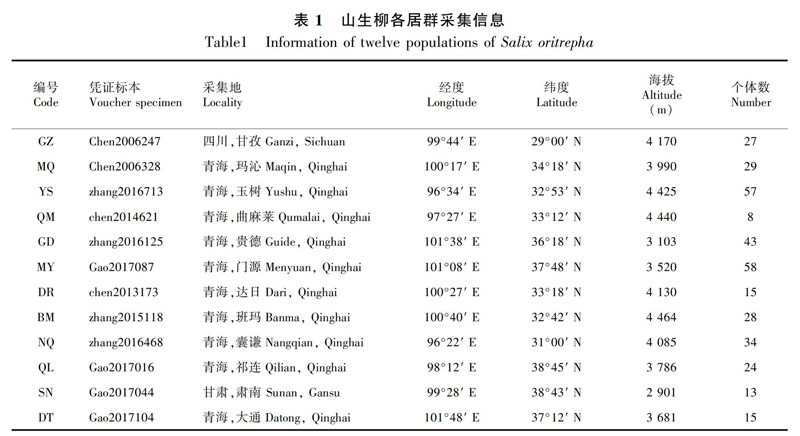 设计并筛选出cpDNA引物5′trnG2G-3′trnG(UUC)和5′rpS12-rpL20,用扩增出的片段和对应的联合片段进行后续的遗传多样性分析。结果表明:通过山生柳的联合片段检测到35种单倍型,单倍型多态性0.626,核苷酸多态性0.000 85。中性检验Tajima’s D(-2.286 70, P<0.01)和Fu’s Fs(-5.298 05, P<0.02)都是顯著负值,推测山生柳个体数近期经历过扩张。AMOVA分析显示,居群内和居群间遗传变异分别为93.70%和6.30%,表明居群内的变异是山生柳遗传变异的主要来源。居群间遗传分化程度中等偏低(FST=0.063),基因流(Nm)为7.439,说明山生柳各居群的基因交流非常频繁,不同地理居群间存在一定的基因流动。遗传分化系数NST(0.075)大于GST(0.068)和基于遗传距离和单倍型的UPGMA聚类分析,表明山生柳12个居群分为4组且与居群的地理分布没有明显相关性。山生柳是进行有性繁殖还是无性繁殖主要受环境因素的影响,居群内变异是山生柳遗传变异性的主要来源,居群间基因交流频繁。
设计并筛选出cpDNA引物5′trnG2G-3′trnG(UUC)和5′rpS12-rpL20,用扩增出的片段和对应的联合片段进行后续的遗传多样性分析。结果表明:通过山生柳的联合片段检测到35种单倍型,单倍型多态性0.626,核苷酸多态性0.000 85。中性检验Tajima’s D(-2.286 70, P<0.01)和Fu’s Fs(-5.298 05, P<0.02)都是顯著负值,推测山生柳个体数近期经历过扩张。AMOVA分析显示,居群内和居群间遗传变异分别为93.70%和6.30%,表明居群内的变异是山生柳遗传变异的主要来源。居群间遗传分化程度中等偏低(FST=0.063),基因流(Nm)为7.439,说明山生柳各居群的基因交流非常频繁,不同地理居群间存在一定的基因流动。遗传分化系数NST(0.075)大于GST(0.068)和基于遗传距离和单倍型的UPGMA聚类分析,表明山生柳12个居群分为4组且与居群的地理分布没有明显相关性。山生柳是进行有性繁殖还是无性繁殖主要受环境因素的影响,居群内变异是山生柳遗传变异性的主要来源,居群间基因交流频繁。
关键词: 山生柳, 基因流, 青藏高原, 叶绿体DNA, 遗传多样性
中图分类号: Q943文献标识码: A文章编号: 1000-3142(2019)09-1180-11
Abstract: We studied the genetic diversity of Salix oritrepha in the Qinghai-Tibetan Plateau using the non-coding region of chloroplast DNA fragments. The study will have guiding significance for the protection of ecological environment and animal husbandry of S. oritrepha and species richness in Qinghai-Tibet Plateau in the future. We designed two useful primers 5′trnG2G-3′trnG (UUC) and 5′rpS12-rpL20. The amplified fragments and their combined fragments were used for subsequent genetic diversity analysis of S. oritrepha. The results showed that we detected 35 haplotypes by the combined sequences, haplotype diversity (Hd) was 0.626, nucleotide diversity (Pi) was 0.000 85. Neutrality tests of Tajima’s D (-2.286 70, P<0.01) and Fus Fs (-5.298 05, P<0.02) showed significantly negative values, which meant that S. oritrepha had expansion recently of its individual numbers. Analysis of molecular variance showed that within-population variance was described as 93.70% of the total variance, while among-population variance was 6.30%, which meant that within-population variance was the main resource of genetic variation of S. oritrepha. The fi-xation index (FST) was 0.063 and number of migrants (Nm) was 7.439, which meant that gene flow was very frequent among different geographical populations. An estimation of non-signification NST (0.075) was bigger than gene differentiation coefficient GST (0.068). UPGMA tree based on genetic distance and haplotypes suggested that all populations were divided into four groups and had no significant correlation with the geographical distribution of the population. The mode of reproduction (sexual or asexual) of S. oritrepha mainly depended on environmental factors. The genetic variability mainly came from within-population and it has a frequently gene flow among populations.
